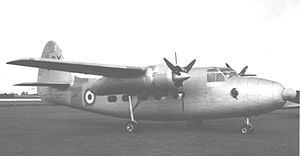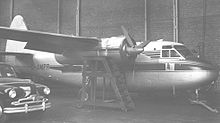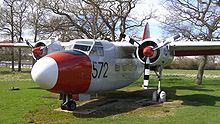Percival Prince Video - Picture

|
|
Percival Prince

Aircraft Picture - Royal Navy Sea Prince T.1 of 727 Squadron FAA from RNAS Brawdy operational with radar nose in September 1956
Role: Transport aircraft
Manufacturer: Percival Aircraft Limited
Designer: Edgar Percival
First flight: 13 May 1948
Number built: 75 of all variants
Developed from: Percival Merganser
The Percival Prince was a British light transport of the early post-war period. It was a twin-engine, high-wing, cantilever monoplane of all-metal stressed-skin construction; the undercarriage was of retractable, tricycle type.
Development
The design of the Prince followed on from the solitary Merganser. Further development of the type led to the Survey Prince survey aircraft and the Sea Prince. An improved version of the Prince 3 with an increased wingspan and engine and undercarriage modifications was developed for the Royal Air Force as the Percival Pembroke.
Operational history

Airplane Picture - Percival Prince 3E executive aircraft of Standard Motor Co. at Croydon Airport in April 1954
The Prince was produced in six marks for the civil market.
The Sea Prince operated in two roles: in T.Mk.1 form it served as a navigation and anti-submarine trainer; the C.Mks. 1 and 2 were flown in the transport role. However, these were landplanes and not COD (carrier on-board delivery) aircraft. Sea Princes operated in both roles from 1954 to 1972 and as a navigation trainer until 1978, when it was replaced by the Handley Page Jetstream
Variants
P.50 Prince 1 - prototype based on Merganser with modified fin and undercarriage and two 520 hp Alvis Leonides 501/4 engine, one built.
P.50 Prince 2 - As Prince 1 with sloping windscreen, stronger mainspar, 5 built.
P.50 Prince 3 - As Prince 2 with Alvis Leonides 502/4 engine and lengthened nose on some aircraft, 12 built.
P.50 Prince 4 - Conversions to Alvis Leonides 503 engines, 10 converted.
P.50 Prince 5 - original designation of the Percival President.
P.50 Prince 6 - Conversions to Alvis Leonides 504 engines.
P.54 Survey Prince - Prince 2 with lengthened transparent nose and camera hatches, 6 built.

Airplane Picture - Sea Prince T.1 preserved at the Gatwick Aviation Museum in 2008
P.57 Sea Prince C1 - Prince 2 for Royal Navy use, 3 built.
P.57 Sea Prince T1 - Prince 3 with long nose housing radar, twin wheeled main undercarriage and lengthened engine nacelles for navigation and anti-submarine training, 41 built.
P.57 Sea Prince C2 - Transport version of Sea Prince T1, 4 built.
Military Operators
Australia
Royal Australian Air Force - Three Princes were in service with the RAAF from 1952 to 1957. The aircraft were used for communications and support duties at the Weapons Research Establishment, Woomera, South Australia.
Air Trials Unit
Thailand
Thai Air Force - One Survey Prince aircraft.
Thai Army - One Survey Prince aircraft.
United Kingdom
Fleet Air Arm
700 Squadron FAA
702 Squadron FAA
727 Squadron FAA
744 Squadron FAA
750 Squadron FAA
781 Squadron FAA
831 Squadron FAA
Royal Naval Reserve
1830 Squadron RNVR
1840 Squadron RNVR
1841 Squadron RNVR
1844 Squadron RNVR
Survivors
On display, Prince, T1-1/98 (cn P.50/41), at Royal Thai Air Force Museum, Don Muang AFB
On display, Sea Prince T.1 WP308 at the Gatwick Aviation Museum, Surrey, England
On display, Sea Prince T.1 WF118 (569) G-DACA at the Gatwick Aviation Museum, Surrey, England
Specifications (Sea Prince T.1)
Data from British Naval Aircraft since 1912
General characteristics
Crew: 2
Capacity: 3 students
Length: 46 ft 4 in (14.13 m)
Wingspan: 56 ft 0 in (17.07 m)
Height: 16 ft 1 in (4.90 m)
Wing area: 365 ft² (33.9 m²)
Empty weight: 8,850 lb (4,023 kg)
Loaded weight: 11,850 lb (5,386 kg)
Powerplant: 2 x— Alvis Leonides 125 radial, 550 hp (411 kW) each
Performance
Maximum speed: 194 knots (223 mph, 359 km/h)
Cruise speed: 159 knots (183 mph, 294 km/h)
Range: 400 nm (460 mi, 740 km)
Service ceiling: 22,000 ft (6,706 m)
Rate of climb: 1,400 ft/min (7.1 m/s)
Armament
none
Related development
Percival Merganser
Percival Pembroke
Percival President
Bibliography
Jackson, A.J. British Civil Aircraft 1919-1972: Volume III. London:Putnam, 1988. ISBN 0 85177 818 6.
Thetford, Owen, British Naval Aircraft since 1912. London:Putnam, 1978. ISBN 0 370 30021 1.
Percival Prince Pictures
More airplane video.
Source: WikiPedia